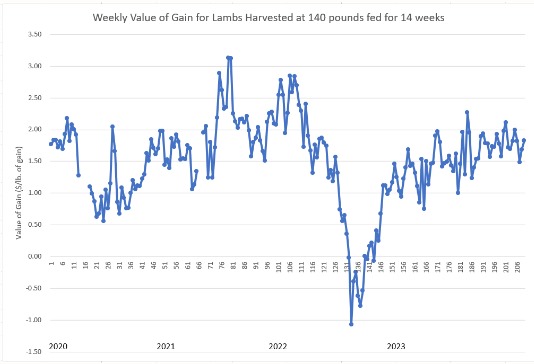By Bradley Zwilling
Illinois FBFM Association and
Department of Agricultural and
Consumer Economics University of Illinois
Total economic returns in 2022 for Illinois beef feeding enterprises exceeded total costs by $25.41 per 100 pounds of beef produced in preliminary findings for farms enrolled in Illinois Farm Business Farm Management (see Table 1). The 2022 returns were higher than the 2021 total returns above feed costs of 19 cents per 100 pounds produced. Total returns have exceeded total economic costs in four out of the last ten years. The 2022 level of return above all costs was $26.66 per 100 pounds beef produced above the average return above all costs for the 2013 through 2022 period. Figure 1 illustrates average returns, cash operating costs and total costs for this same period.

Higher Total Returns
Higher prices received contributed to the higher total returns for these enterprises. Total returns per 100 pounds produced increased from $107.65 in 2021 to $141.77 in 2022. Total returns for 2022 were the highest on record. The average price received per 100 pounds of beef sold of $143.84 was 19 percent higher than 2021. This price was the third highest price received since this study began with 2014 and 2015 being the highest with $147.19 and $149.47, respectively. The average price paid for feeder cattle replacements in 2022 of $163.17 was 17 percent higher than 2021. This was the highest price paid for feeder cattle replacements since 2015. The price paid for feeder cattle in 2014 and 2015 were the only years where the price paid averaged over $200.00 per hundredweight. The purchase cost of feeder cattle is subtracted from finished cattle sales in determining total returns per 100 pounds produced.
Feed Costs Continue to Increase
Higher feed costs were not enough to offset the much higher gross returns as compared to 2021. Feed costs increased 11 percent in 2022 as compared to 2021. Feed costs were $82.79 per 100 pounds produced in 2022 compared to $74.66 in 2021. Non-feed costs increased from $33.18 per 100 pounds produced in 2021 to $33.54 in 2022. Maintenance and power expenses of $8.37 per 100 pounds produced make up the largest portion of the non-feed costs. Feed and non-feed costs were $116.33 per 100 pounds produced in 2022. Total costs in 2022 were $8.49 per 100 pounds produced above 2021 and $20.70 above the last ten-year average of $95.63. Excluding the cost of feeder cattle, feed costs were 71 percent of the total cost to produce beef in 2022, compared to 67 percent for the four-year average.
Summary and Projections for 2023
Returns to cattle feeders increased in 2022 compared to 2021 and were above the last four-year average. The increase in price received was the main factor for the increased returns. Higher feed costs offset some of the higher returns. Projections for 2023 show that beef production is estimated to decrease about 5% and thus market cattle prices are expected to increase about 15%. Returns for 2023 will increase due to higher cattle prices. Feed costs will be lower with projected lower grain and forage prices. With these factors combined, returns to all costs for 2023 are estimated to be higher than 2022.
The author would like to acknowledge that data used in this study comes from Illinois Farm Business Farm Management (FBFM) Associations across the state. Without their cooperation, information as comprehensive and accurate as this would not be available for educational purposes. FBFM, which consists of 5,000 plus farmers and 65 plus professional field staff, is a not-for-profit organization available to all farm operators in Illinois. FBFM field staff provide on-farm counsel with recordkeeping, farm financial management, business entity planning and income tax management. For more information, please contact the State FBFM Office located at the University of Illinois Department of Agricultural and Consumer Economics at 217-333-8346 or visit the FBFM website at www.fbfm.org.
Source : illinois.edu